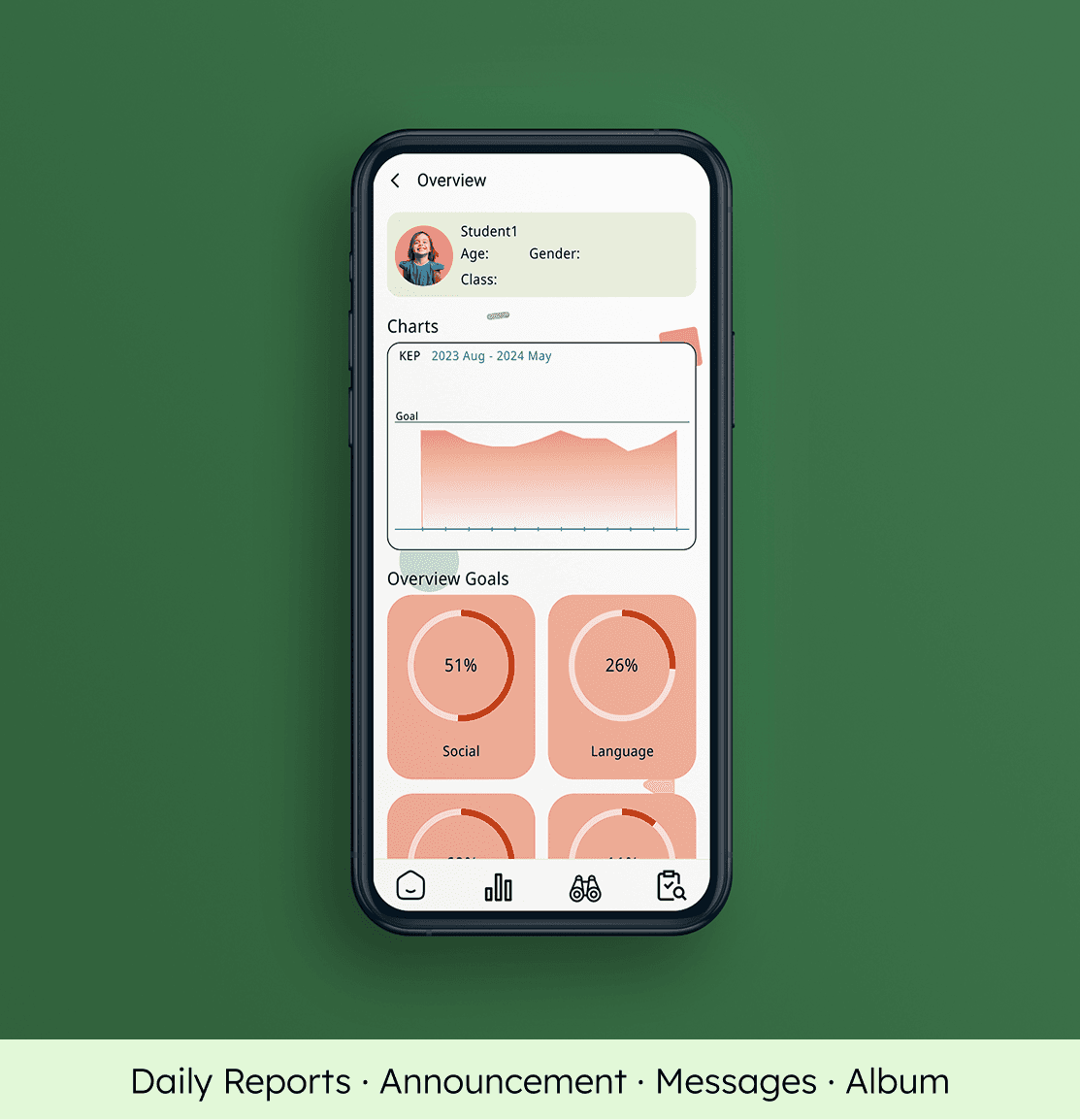KidsBell
A Communication Platform for Korean kindergarten Teachers and Multicultural Families

Individual Project
Role: Product designer(User research, prototyping, UI design, User Test)
DURATION
JUL 2024 - AUG 2024
TOOLS
Figma
Overview
Imagine a kindergarten teacher juggling dozens of messages from parents each day. Some arrive during class and others late at night. Most rely on personal apps or paper notes to stay in touch, making it hard to separate work from rest.
To simplify daily communication between teachers and caregivers, while reducing stress and supporting diverse family needs.
Current communication tools are fragmented and stressful. Teachers struggle to protect their time and privacy, while caregivers lack clear and accessible ways to stay informed about their child’s day.
This challenge inspired Kidsbell, a centralized platform designed to balance both perspectives. It provides in-app messaging with time boundaries, automatic translation for multilingual families, and an emotionally clear and simple space for daily connection between teachers and parents.
Problem & User
To identify key communication pain points and emotional needs in daily teachers–caregivers interaction, focusing on boundaries, workload, and children’s daily experience.



To better understand user needs, I conducted surveys and interviews:
29 kindergarten teachers + 23 caregivers (including multicultural family members)
The research focused on:
Teachers’ stress from constant caregivers messages and blurred boundaries
Language barriers making daily updates difficult for multicultural families
Caregivers’ and teachers’ openness to in-app chat as a safer, simpler tool



Insights



This research highlighted both stress (teachers’ boundaries) and needs (caregivers’ wish to see their child’s emotions).
It informed the design of features like Daily Emotion Cards and Manner Time, supporting balanced and meaningful communication.

I identified two key user types: kindergarten teachers and multicultural caregivers, who shared similar frustrations around communication.
(Click on each flowchart to zoom in.)



Key User insights
Teachers feel stressed by late-night caregivers messages and juggling multiple tools.
Caregivers want to follow their child’s emotions and well-being, not just activity details.
Both groups expect communication that feels respectful, human-centered, and sustainable in daily life.
Problem Statement
Teachers in Korea lose time and energy due to fragmented communication and after-hours contact.
Multicultural families struggle with language barriers that make updates harder to follow.
There is a need for a tool that not only increases efficiency but also builds trust and fosters shared emotional clarity between teachers and caregivers.
Goals & Principles
"How might we design a communication experience that protects teachers’ time and helps caregivers connect with their child’s day?"
Research showed that focusing only on efficiency (blocking messages, reducing admin work) was not enough.
For teachers, I designed Manner Time: a feature that respects their rest while keeping caregivers informed with queued messages and friendly reminders.
For caregivers, I designed Daily Emotion Cards: a clear, visual summary that shows the child’s mood and encourages meaningful conversations at home.
This direction transforms the product from a functional tool into a shared communication experience that strengthens relationships, respects boundaries, and supports emotional connection
Flows & Structure
To address key pain points in communication, I designed separate flows for two main users: teachers and caregivers.
The goal was to reduce stress, protect time boundaries, and make updates clear and accessible across languages.
Teacher’s Flow:
Teachers share daily reports and afternoon moods only during work hours.
After-hours messages are queued with Manner Time, protecting rest while keeping caregivers informed.
(Click on each flowchart to zoom in.)

Caregiver's Flow:
Caregivers log morning moods and later review the Daily Emotion Card with teacher updates.
Messages are sent instantly during work hours, or queued with a friendly popup after hours.
(Click on each flowchart to zoom in.)

Why this structure?
The flows reflect daily dynamics marked by time pressure, emotional sensitivity, and relational trust gaps.

Prototyping
I created low-fidelity wireframes to explore task flows and layout structure, then translated them into high-fidelity screens focused on clarity, accessibility, and workflow efficiency.
user testing
To evaluate usability and clarity of key interactions, I ran a low-fidelity prototype test with teachers and caregivers.
The focus was on Manner Time, ensuring after-hours messages were safely queued with clear caregivers feedback, and the Daily Emotion Card, combining caregivers and teachers inputs into a shared emotional summary.

Hi-fidelity prototype
These screens show how KidsBell simplifies communication between teachers and caregivers while protecting personal boundaries.
The design highlights real-time updates, respectful notifications, and visual emotional summaries for diverse families.
(Click on each flowchart to zoom in.)

These changes were driven by user pain points and tested through design critiques, ensuring that each screen supports clarity, privacy, and time efficiency.
Interaction Details
All interactions in KidsBell were designed not just for efficiency, but to reduce stress, respect boundaries, and turn updates into shared emotional experiences.
Daily Emotion Card
What happens:
Caregivers log their child’s morning mood
Teachers update with afternoon observations
The app combines both into a Daily Emotion Card that families can review at home
Why it matters:
Turns updates from transactional reports into a shared emotional narrative.
Helps caregivers start meaningful conversations with their child.
Strengthens connection between families and teachers through clear, visual communication.
“A simple card that turns daily routines into meaningful family moments.”

Manner Time (Quiet Hours)
What happens:
Messages sent after school hours are queued automatically.
Caregivers see a friendly popup.
The message is delivered the next morning when the teacher is available.
Why it matters:
Protects teachers’ work–life balance without breaking caregivers trust.
Gives caregivers reassurance that their message is safe and will be delivered.
Builds a healthier, respect-based communication culture between teachers and families.
“Quiet hours that protect teachers’ time while keeping guardians connected.”

Testing & Learnings
What I tested:
Message scheduling & quiet hours
Daily Emotion Card flow (guardians input AM → teacher update PM)
Multilingual translation toggle
Key learnings:
Teachers felt more relaxed when messages respected quiet hours and personal phones were not required
Caregivers responded positively to short emotion-based summaries and found them more engaging than long reports.
Clear boundaries reduced stress and strengthened trust
Next improvements:
Add auto-reply messages for busy daytime hours.
Simplify reactions and replies for caregivers


